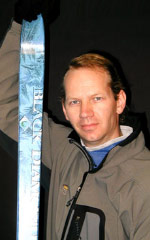
Wave Vidmar
1st American to attempt a solo unsupported
expedition to the North Pole
 View the entries
View the entries
from Wave's logbook

Live from February 2004
through
April 2004

 |
 |
Earth Sciences |
 |
 |
Environmental
Sciences |
 |
 |
Ecology |
 |
 |
Leadership & Goal Setting |
 |
 |
Communications |
 |
 |
Safety
Precautions |
 |
 |
Equipment |

To register for this project,
send email to
helper@gsn.org
and include the following information:
- Teacher name
- Name of school or organization
- Location of school or organization
- Grade level of students
- Number of students in class
|
Visit this website often to read Wave's dispatches and to
view his digital images.
|
|
 |

Students are introduced to the ecosystem of
the North Pole - as they learn about
earth sciences, environmental sciences,
ecology, and North Pole history. They are inspired to set goals that will help
them achieve their dreams.
Talking to Wave from the North
Pole
Three classrooms had the
incredible opportunity to speak with Wave live from
the North Pole via satellite phone!!!
Select a link
below to view the video:
Dial-up DSL
Cable Modem
|
Goal
Wave Vidmar
walked into history as the first American to attempt
a 660 mile solo journey to the geographic North Pole.
The expedition took approximately 60 days across
the frozen Arctic sea ice.
Wave left his hometown of Oakland, California (right across the bay from San
Francisco) and set off for Russia. Then, leaving from upper Russia, the Artichevsky peninsula, Wave walked, skied, and swam nearly 660 miles to the
North Pole!
Dragging a sledge (pulk)
weighing more than 325 lbs Wave took with him everything he needed to accomplish his goal
through the harshest environment on earth. When asked why he would do such a
thing he states "to feed my soul." |
 |
The North Pole
For centuries men (and women) have been drawn to
the 'top of the world' - the north pole. One of the most, if not
the most difficult place to visit, the north pole has had less people
stand on it than on the summit of Mount Everest.
There are actually two north poles, the geographic north pole and the
magnetic north pole. There is no land beneath the ice that covers the north
pole. In fact, at times there is no ice and only water. The ice covering
Antarctica (the south pole) is approx. 3000 feet thick, while the ice at the
north pole is no thicker than 17 feet, typically much less.
There are no markers or 'poles' (as at the south pole), as the ice that
typically covers the north pole is constantly moving. The water beneath the
pole is over 14,000 feet deep. Average temperatures at the pole are -30°F, and
can go as low as -74°F, with wind-chill can go as low as -150°F. That's cold! |
|
|
 |
The nature of the expedition
precludes direct interaction with Wave while he is on the expedition;
however, students can track this adventure online, submit questions via email,
and get great ideas for lesson plans. Collaborative activities include:
- writing essays
- conducting and sharing research
- producing captions for digital photos
- creating web hunts
|
|
|
| | |